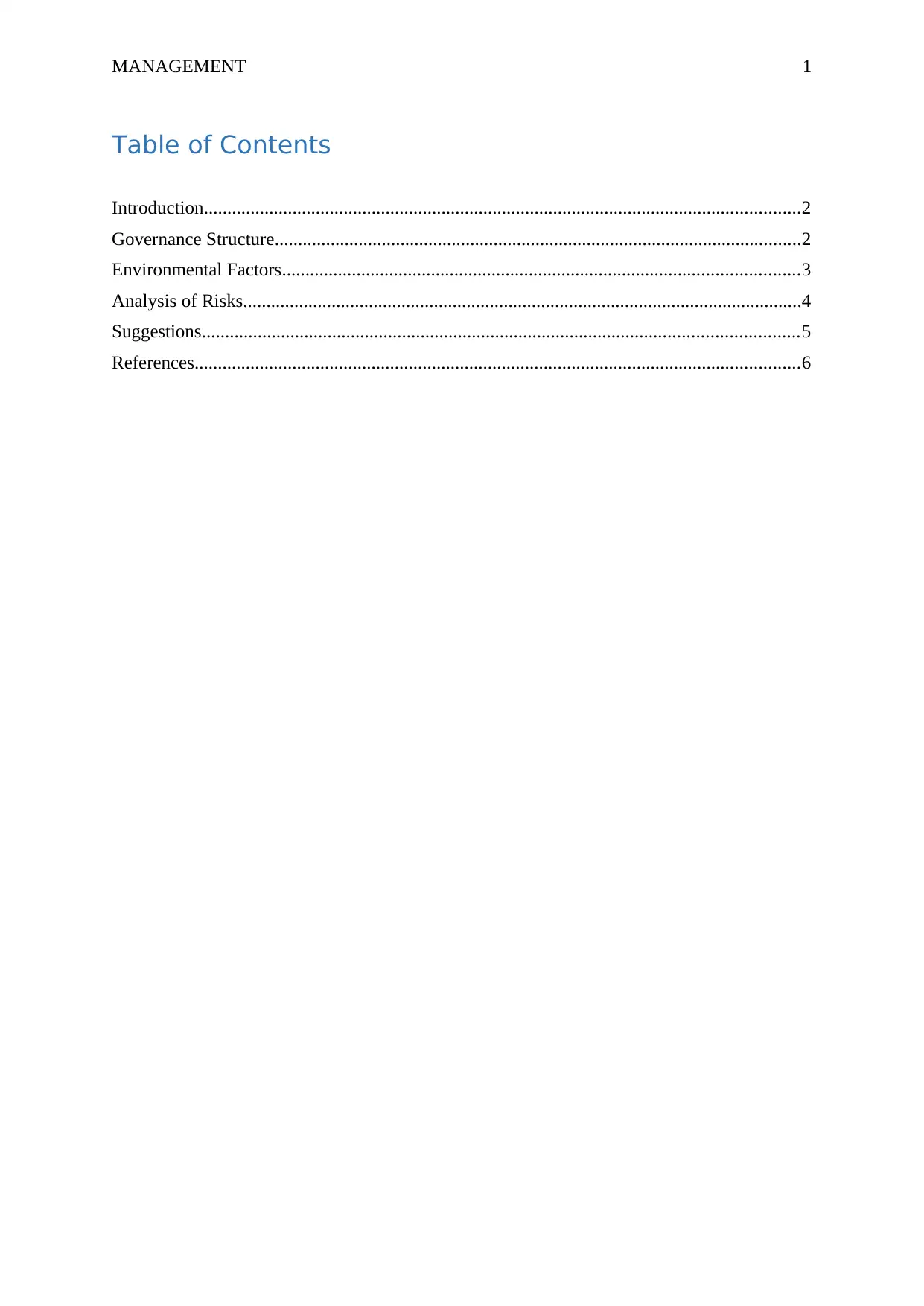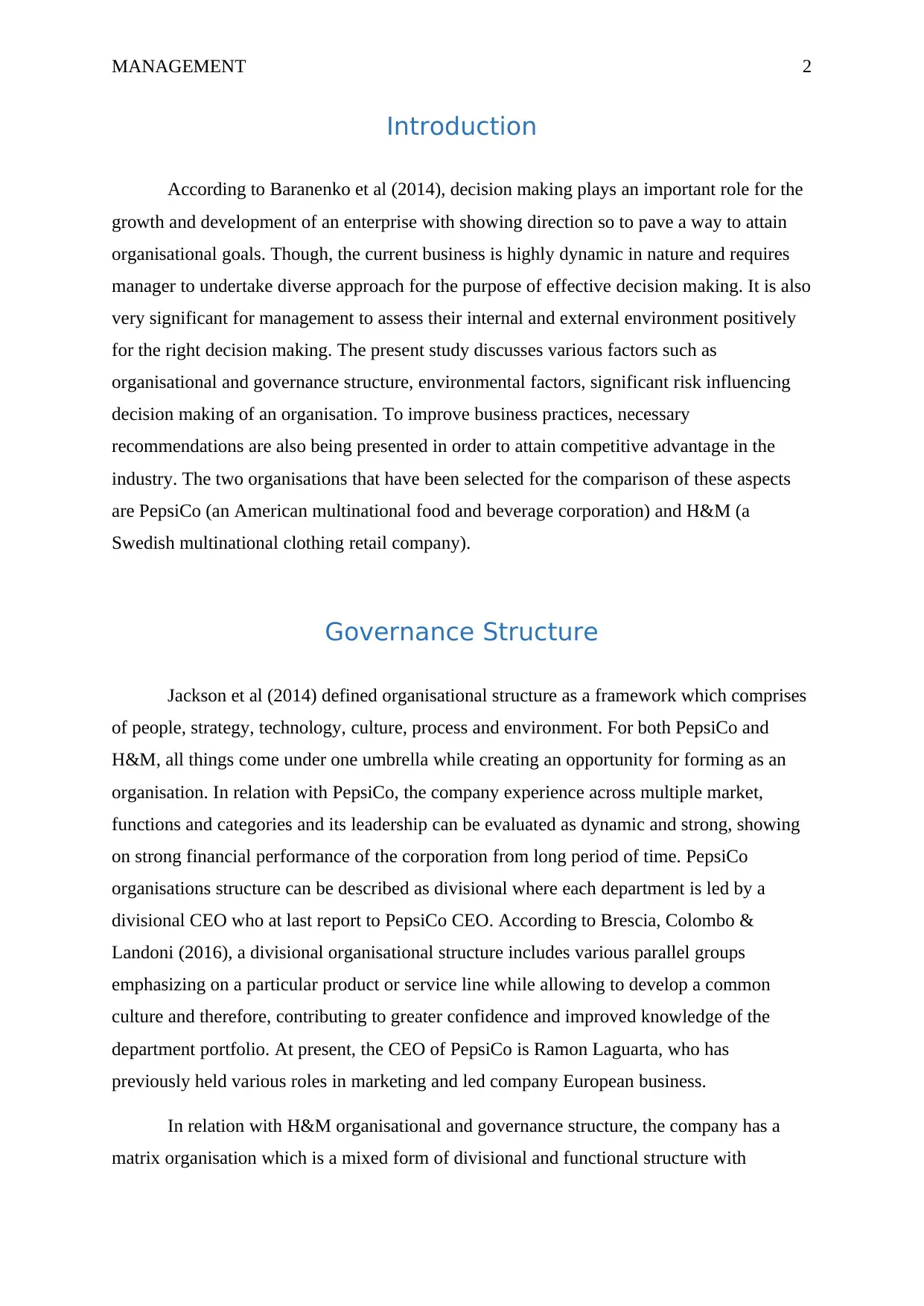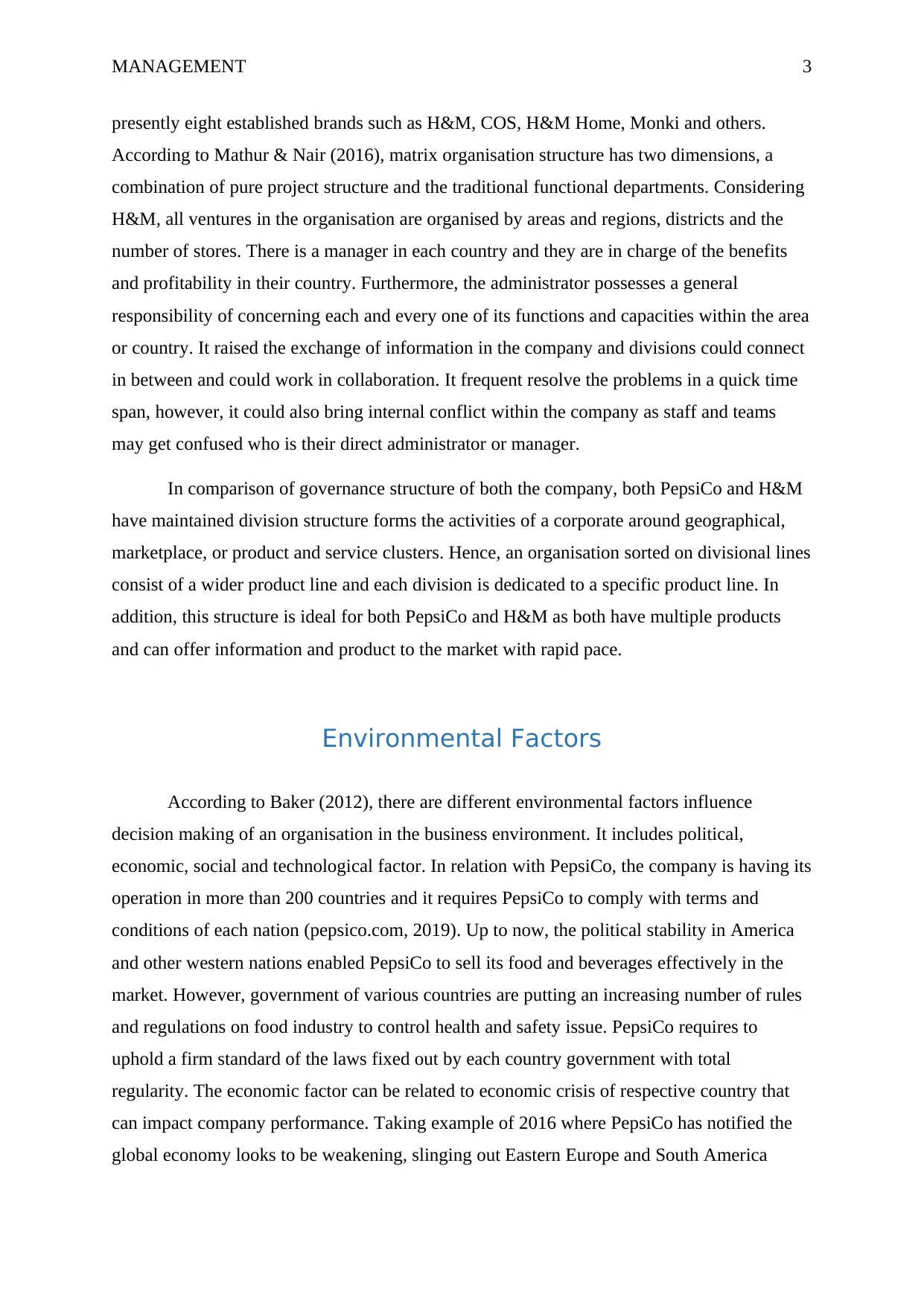Report on Management and Business Context: PepsiCo and H&M Comparison
VerifiedAdded on 2022/09/09
|7
|2045
|18
Report
AI Summary
This report provides a comparative analysis of the management and business contexts of PepsiCo and H&M. It begins by examining their respective governance structures, highlighting PepsiCo's divisional structure and H&M's matrix organization. The report then delves into the environmental factors influencing each company, including political, economic, social, and technological aspects. A significant portion of the report is dedicated to analyzing the key risks faced by both organizations, such as intense competition, Brexit's impact, digitalization, and foreign currency fluctuations. Finally, the report offers strategic suggestions for improving business practices, including product diversification, international market expansion, and strengthening online platforms, ultimately aiming to enhance competitive advantage in the industry. References to academic sources and industry reports are included to support the analysis.

Running Head: MANAGEMENT 0
Management and Business context
Management and Business context
Paraphrase This Document
Need a fresh take? Get an instant paraphrase of this document with our AI Paraphraser

MANAGEMENT 1
Table of Contents
Introduction................................................................................................................................2
Governance Structure.................................................................................................................2
Environmental Factors...............................................................................................................3
Analysis of Risks........................................................................................................................4
Suggestions................................................................................................................................5
References..................................................................................................................................6
Table of Contents
Introduction................................................................................................................................2
Governance Structure.................................................................................................................2
Environmental Factors...............................................................................................................3
Analysis of Risks........................................................................................................................4
Suggestions................................................................................................................................5
References..................................................................................................................................6

MANAGEMENT 2
Introduction
According to Baranenko et al (2014), decision making plays an important role for the
growth and development of an enterprise with showing direction so to pave a way to attain
organisational goals. Though, the current business is highly dynamic in nature and requires
manager to undertake diverse approach for the purpose of effective decision making. It is also
very significant for management to assess their internal and external environment positively
for the right decision making. The present study discusses various factors such as
organisational and governance structure, environmental factors, significant risk influencing
decision making of an organisation. To improve business practices, necessary
recommendations are also being presented in order to attain competitive advantage in the
industry. The two organisations that have been selected for the comparison of these aspects
are PepsiCo (an American multinational food and beverage corporation) and H&M (a
Swedish multinational clothing retail company).
Governance Structure
Jackson et al (2014) defined organisational structure as a framework which comprises
of people, strategy, technology, culture, process and environment. For both PepsiCo and
H&M, all things come under one umbrella while creating an opportunity for forming as an
organisation. In relation with PepsiCo, the company experience across multiple market,
functions and categories and its leadership can be evaluated as dynamic and strong, showing
on strong financial performance of the corporation from long period of time. PepsiCo
organisations structure can be described as divisional where each department is led by a
divisional CEO who at last report to PepsiCo CEO. According to Brescia, Colombo &
Landoni (2016), a divisional organisational structure includes various parallel groups
emphasizing on a particular product or service line while allowing to develop a common
culture and therefore, contributing to greater confidence and improved knowledge of the
department portfolio. At present, the CEO of PepsiCo is Ramon Laguarta, who has
previously held various roles in marketing and led company European business.
In relation with H&M organisational and governance structure, the company has a
matrix organisation which is a mixed form of divisional and functional structure with
Introduction
According to Baranenko et al (2014), decision making plays an important role for the
growth and development of an enterprise with showing direction so to pave a way to attain
organisational goals. Though, the current business is highly dynamic in nature and requires
manager to undertake diverse approach for the purpose of effective decision making. It is also
very significant for management to assess their internal and external environment positively
for the right decision making. The present study discusses various factors such as
organisational and governance structure, environmental factors, significant risk influencing
decision making of an organisation. To improve business practices, necessary
recommendations are also being presented in order to attain competitive advantage in the
industry. The two organisations that have been selected for the comparison of these aspects
are PepsiCo (an American multinational food and beverage corporation) and H&M (a
Swedish multinational clothing retail company).
Governance Structure
Jackson et al (2014) defined organisational structure as a framework which comprises
of people, strategy, technology, culture, process and environment. For both PepsiCo and
H&M, all things come under one umbrella while creating an opportunity for forming as an
organisation. In relation with PepsiCo, the company experience across multiple market,
functions and categories and its leadership can be evaluated as dynamic and strong, showing
on strong financial performance of the corporation from long period of time. PepsiCo
organisations structure can be described as divisional where each department is led by a
divisional CEO who at last report to PepsiCo CEO. According to Brescia, Colombo &
Landoni (2016), a divisional organisational structure includes various parallel groups
emphasizing on a particular product or service line while allowing to develop a common
culture and therefore, contributing to greater confidence and improved knowledge of the
department portfolio. At present, the CEO of PepsiCo is Ramon Laguarta, who has
previously held various roles in marketing and led company European business.
In relation with H&M organisational and governance structure, the company has a
matrix organisation which is a mixed form of divisional and functional structure with
⊘ This is a preview!⊘
Do you want full access?
Subscribe today to unlock all pages.

Trusted by 1+ million students worldwide

MANAGEMENT 3
presently eight established brands such as H&M, COS, H&M Home, Monki and others.
According to Mathur & Nair (2016), matrix organisation structure has two dimensions, a
combination of pure project structure and the traditional functional departments. Considering
H&M, all ventures in the organisation are organised by areas and regions, districts and the
number of stores. There is a manager in each country and they are in charge of the benefits
and profitability in their country. Furthermore, the administrator possesses a general
responsibility of concerning each and every one of its functions and capacities within the area
or country. It raised the exchange of information in the company and divisions could connect
in between and could work in collaboration. It frequent resolve the problems in a quick time
span, however, it could also bring internal conflict within the company as staff and teams
may get confused who is their direct administrator or manager.
In comparison of governance structure of both the company, both PepsiCo and H&M
have maintained division structure forms the activities of a corporate around geographical,
marketplace, or product and service clusters. Hence, an organisation sorted on divisional lines
consist of a wider product line and each division is dedicated to a specific product line. In
addition, this structure is ideal for both PepsiCo and H&M as both have multiple products
and can offer information and product to the market with rapid pace.
Environmental Factors
According to Baker (2012), there are different environmental factors influence
decision making of an organisation in the business environment. It includes political,
economic, social and technological factor. In relation with PepsiCo, the company is having its
operation in more than 200 countries and it requires PepsiCo to comply with terms and
conditions of each nation (pepsico.com, 2019). Up to now, the political stability in America
and other western nations enabled PepsiCo to sell its food and beverages effectively in the
market. However, government of various countries are putting an increasing number of rules
and regulations on food industry to control health and safety issue. PepsiCo requires to
uphold a firm standard of the laws fixed out by each country government with total
regularity. The economic factor can be related to economic crisis of respective country that
can impact company performance. Taking example of 2016 where PepsiCo has notified the
global economy looks to be weakening, slinging out Eastern Europe and South America
presently eight established brands such as H&M, COS, H&M Home, Monki and others.
According to Mathur & Nair (2016), matrix organisation structure has two dimensions, a
combination of pure project structure and the traditional functional departments. Considering
H&M, all ventures in the organisation are organised by areas and regions, districts and the
number of stores. There is a manager in each country and they are in charge of the benefits
and profitability in their country. Furthermore, the administrator possesses a general
responsibility of concerning each and every one of its functions and capacities within the area
or country. It raised the exchange of information in the company and divisions could connect
in between and could work in collaboration. It frequent resolve the problems in a quick time
span, however, it could also bring internal conflict within the company as staff and teams
may get confused who is their direct administrator or manager.
In comparison of governance structure of both the company, both PepsiCo and H&M
have maintained division structure forms the activities of a corporate around geographical,
marketplace, or product and service clusters. Hence, an organisation sorted on divisional lines
consist of a wider product line and each division is dedicated to a specific product line. In
addition, this structure is ideal for both PepsiCo and H&M as both have multiple products
and can offer information and product to the market with rapid pace.
Environmental Factors
According to Baker (2012), there are different environmental factors influence
decision making of an organisation in the business environment. It includes political,
economic, social and technological factor. In relation with PepsiCo, the company is having its
operation in more than 200 countries and it requires PepsiCo to comply with terms and
conditions of each nation (pepsico.com, 2019). Up to now, the political stability in America
and other western nations enabled PepsiCo to sell its food and beverages effectively in the
market. However, government of various countries are putting an increasing number of rules
and regulations on food industry to control health and safety issue. PepsiCo requires to
uphold a firm standard of the laws fixed out by each country government with total
regularity. The economic factor can be related to economic crisis of respective country that
can impact company performance. Taking example of 2016 where PepsiCo has notified the
global economy looks to be weakening, slinging out Eastern Europe and South America
Paraphrase This Document
Need a fresh take? Get an instant paraphrase of this document with our AI Paraphraser

MANAGEMENT 4
specifically (Esterl, 2016). The social factors that can impact company performance include
change in culture from carbonated drinks to healthy beverages. PepsiCo brand image is
perceived as one of the leading carbonated drink, however, due to health concerns, people
taste can be shifted more near healthy drinks. To increase the performance, PepsiCo also
requires to leverage big data and other integrated technology in order to optimise supply
chain as the company deals in 200 countries while catering one billion customers each day.
Considering H&M, the total number of H&M stores globally is around 4, 968 and its
major stores lie in the United States, Germany and China (hmgroup.com, 2019). The political
factors that can impact H&M performance are the fluctuating leaders in the Europe, USA and
Asia as well as de-globalisation flood crossways the world. Changing economies of scale in
terms of economic factors are also shifting back from one developing nation to other region
and therefore, the labour cost, operations, production together with marketing pose various
challenges to the organisation. In relation with social aspects, social media also poses a
challenging threat with emerging as a storefront for fashion retailers. Furthermore, to
counterfeit competitors and increase performance, H&M requires to adopt online channels at
a greater pace in integration with innovative technologies such as data analysis and AI.
Analysis of Risks
Every business faces some sorts of risks that could present threats to its sustainability
and achievements. The top three risks that are being faced by PepsiCo are intense
competition, impact of Brexit and restructuring and acquisition costs. From past several
years, PepsiCo is struggling in a challenging environment due to its competition from Coca-
Cola and companies offering healthy beverages. Brexit also leads a significant threat to
PepsiCo resulting in closing of British plant while affecting approximately 400 jobs (Reuters,
2017). It impacts decision making of the PepsiCo as the changes are proposing significant
productivity losses and threaten sustainable growth in the UK. The last risk is acquisition and
restructuring costs where the credit rating of PepsiCo was pull down as of the debt it seized
on to account bottler attainments and ultimately force bottom line growth in the short time
span. It requires PepsiCo to take necessary decisions as of lesser return on investment and
rising product cost weights.
specifically (Esterl, 2016). The social factors that can impact company performance include
change in culture from carbonated drinks to healthy beverages. PepsiCo brand image is
perceived as one of the leading carbonated drink, however, due to health concerns, people
taste can be shifted more near healthy drinks. To increase the performance, PepsiCo also
requires to leverage big data and other integrated technology in order to optimise supply
chain as the company deals in 200 countries while catering one billion customers each day.
Considering H&M, the total number of H&M stores globally is around 4, 968 and its
major stores lie in the United States, Germany and China (hmgroup.com, 2019). The political
factors that can impact H&M performance are the fluctuating leaders in the Europe, USA and
Asia as well as de-globalisation flood crossways the world. Changing economies of scale in
terms of economic factors are also shifting back from one developing nation to other region
and therefore, the labour cost, operations, production together with marketing pose various
challenges to the organisation. In relation with social aspects, social media also poses a
challenging threat with emerging as a storefront for fashion retailers. Furthermore, to
counterfeit competitors and increase performance, H&M requires to adopt online channels at
a greater pace in integration with innovative technologies such as data analysis and AI.
Analysis of Risks
Every business faces some sorts of risks that could present threats to its sustainability
and achievements. The top three risks that are being faced by PepsiCo are intense
competition, impact of Brexit and restructuring and acquisition costs. From past several
years, PepsiCo is struggling in a challenging environment due to its competition from Coca-
Cola and companies offering healthy beverages. Brexit also leads a significant threat to
PepsiCo resulting in closing of British plant while affecting approximately 400 jobs (Reuters,
2017). It impacts decision making of the PepsiCo as the changes are proposing significant
productivity losses and threaten sustainable growth in the UK. The last risk is acquisition and
restructuring costs where the credit rating of PepsiCo was pull down as of the debt it seized
on to account bottler attainments and ultimately force bottom line growth in the short time
span. It requires PepsiCo to take necessary decisions as of lesser return on investment and
rising product cost weights.

MANAGEMENT 5
In relation with H&M, the first risk that company is facing is the growing
digitalization. Today, more people are inclined towards purchasing products through online
channel and it brings out a greater challenges for physical retail stores. This year also, H&M
planning to close 160 stores due to rising investment cost as well as change of competitive
landscape (Shively, 2019). It impacts H&M decision making to seize or extend the capacity
and resources for fit in its physical stores highly with its online platform. Foreign currency is
another risk where the most significant currencies for group buying are the euro and US
dollar. Fluctuations in the US dollars exchange rate alongside the euro is one of the single
largest foreign currency transaction experience for the group. It impacts company decision
making on how to hedge the flow of goods in foreign currencies and therefore, decrease the
impact of future fluctuations of exchange rates. The last risk is that H&M is facing is tax
disputes in terms of the local tax authorities where the company requires to have to take
necessary decisions that its tax compliance plan is intended to bound any distortion occurring
from variances in tax legislature considering various corners at the globe.
Suggestions
To improve the business practices, the first suggestions to PepsiCo is to making
products that can be taken out as healthy replacements to their consumers as individuals these
days are seeing for means to stay well while eating healthy. The second suggestion to
PepsiCo is to enlarge the focus out of the US and into the international market. PepsiCo by
this time has its presence world-wide, however, the market they emphasize the most is in the
US. To showcase its environment sustainability, PepsiCo can connect with people through
social media at a greater pace with sharing of more insights.
In relation with H&M, the company should strengthen its online platform through
disinvestment from physical stores with ensuring accurate, reliable and transparent
communication throughout the functional areas. The company also requires to anticipate
needs of innovation in line with latest trends such as retail and virtual merchandising, 3D
scanning, Novel fabrics and many more. It will further help H&M to improve its business
practices while attaining competitive edge in the industry. Ultimately, H&M also requires to
focus on different store redesigns to help drive traffic as the competitive landscape is being
redrawn with the competitors including Zara, UNIQLO and Inditex.
In relation with H&M, the first risk that company is facing is the growing
digitalization. Today, more people are inclined towards purchasing products through online
channel and it brings out a greater challenges for physical retail stores. This year also, H&M
planning to close 160 stores due to rising investment cost as well as change of competitive
landscape (Shively, 2019). It impacts H&M decision making to seize or extend the capacity
and resources for fit in its physical stores highly with its online platform. Foreign currency is
another risk where the most significant currencies for group buying are the euro and US
dollar. Fluctuations in the US dollars exchange rate alongside the euro is one of the single
largest foreign currency transaction experience for the group. It impacts company decision
making on how to hedge the flow of goods in foreign currencies and therefore, decrease the
impact of future fluctuations of exchange rates. The last risk is that H&M is facing is tax
disputes in terms of the local tax authorities where the company requires to have to take
necessary decisions that its tax compliance plan is intended to bound any distortion occurring
from variances in tax legislature considering various corners at the globe.
Suggestions
To improve the business practices, the first suggestions to PepsiCo is to making
products that can be taken out as healthy replacements to their consumers as individuals these
days are seeing for means to stay well while eating healthy. The second suggestion to
PepsiCo is to enlarge the focus out of the US and into the international market. PepsiCo by
this time has its presence world-wide, however, the market they emphasize the most is in the
US. To showcase its environment sustainability, PepsiCo can connect with people through
social media at a greater pace with sharing of more insights.
In relation with H&M, the company should strengthen its online platform through
disinvestment from physical stores with ensuring accurate, reliable and transparent
communication throughout the functional areas. The company also requires to anticipate
needs of innovation in line with latest trends such as retail and virtual merchandising, 3D
scanning, Novel fabrics and many more. It will further help H&M to improve its business
practices while attaining competitive edge in the industry. Ultimately, H&M also requires to
focus on different store redesigns to help drive traffic as the competitive landscape is being
redrawn with the competitors including Zara, UNIQLO and Inditex.
⊘ This is a preview!⊘
Do you want full access?
Subscribe today to unlock all pages.

Trusted by 1+ million students worldwide

MANAGEMENT 6
References
Baker, J. (2012). The technology–organization–environment framework. In Information
systems theory (pp. 231-245). Springer, New York.
Baranenko, S., Dudin, M., Lyasnikov, N., & Busygin, K. (2014). Use of environmental
approach to innovation-oriented development of industrial enterprises. American
journal of applied sciences, 11(2), 189-194.
Brescia, F., Colombo, G., & Landoni, P. (2016). Organizational structures of Knowledge
Transfer Offices: an analysis of the world’s top-ranked universities. The Journal of
Technology Transfer, 41(1), 132-151.
Esterl, M. (2016). PepsiCo Warns of Weakening Global Economy. Retrieved from
https://www.wsj.com/articles/pepsico-earnings-top-expectations-1460978140
hmgroup.com. (2019). Market Overview. Retrieved from
https://hmgroup.com/about-us/markets-and-expansion/market-overview.html
Jackson, S. E., Schuler, R. S., & Jiang, K. (2014). An aspirational framework for strategic
human resource management. The Academy of Management Annals, 8(1), 1-56.
Mathur, P., & Nair, M. (2016). Organization structure a key to driver to competitive
advantage. International Journal of Management and Commerce Innovations, 3(2),
348-356.
pepsico.com. (2019). ABOUT THE COMPANY. Retrieved from
https://www.pepsico.com/about/about-the-company
Reuters, T. (2017). PepsiCo To Close British Plant, Threatening Nearly 400 Jobs. Retrieved
from https://www.ndtv.com/business/pepsico-to-close-british-plant-threatening-
nearly-400-jobs-1665048
Shively, H. (2019). Clothing giant H&M planning to close 160 stores in 2019. Retrieved
from https://www.boston25news.com/news/trending-now/clothing-giant-hm-
planning-to-close-160-stores-in-2019/914690149/
References
Baker, J. (2012). The technology–organization–environment framework. In Information
systems theory (pp. 231-245). Springer, New York.
Baranenko, S., Dudin, M., Lyasnikov, N., & Busygin, K. (2014). Use of environmental
approach to innovation-oriented development of industrial enterprises. American
journal of applied sciences, 11(2), 189-194.
Brescia, F., Colombo, G., & Landoni, P. (2016). Organizational structures of Knowledge
Transfer Offices: an analysis of the world’s top-ranked universities. The Journal of
Technology Transfer, 41(1), 132-151.
Esterl, M. (2016). PepsiCo Warns of Weakening Global Economy. Retrieved from
https://www.wsj.com/articles/pepsico-earnings-top-expectations-1460978140
hmgroup.com. (2019). Market Overview. Retrieved from
https://hmgroup.com/about-us/markets-and-expansion/market-overview.html
Jackson, S. E., Schuler, R. S., & Jiang, K. (2014). An aspirational framework for strategic
human resource management. The Academy of Management Annals, 8(1), 1-56.
Mathur, P., & Nair, M. (2016). Organization structure a key to driver to competitive
advantage. International Journal of Management and Commerce Innovations, 3(2),
348-356.
pepsico.com. (2019). ABOUT THE COMPANY. Retrieved from
https://www.pepsico.com/about/about-the-company
Reuters, T. (2017). PepsiCo To Close British Plant, Threatening Nearly 400 Jobs. Retrieved
from https://www.ndtv.com/business/pepsico-to-close-british-plant-threatening-
nearly-400-jobs-1665048
Shively, H. (2019). Clothing giant H&M planning to close 160 stores in 2019. Retrieved
from https://www.boston25news.com/news/trending-now/clothing-giant-hm-
planning-to-close-160-stores-in-2019/914690149/
1 out of 7
Related Documents
Your All-in-One AI-Powered Toolkit for Academic Success.
+13062052269
info@desklib.com
Available 24*7 on WhatsApp / Email
![[object Object]](/_next/static/media/star-bottom.7253800d.svg)
Unlock your academic potential
Copyright © 2020–2025 A2Z Services. All Rights Reserved. Developed and managed by ZUCOL.





